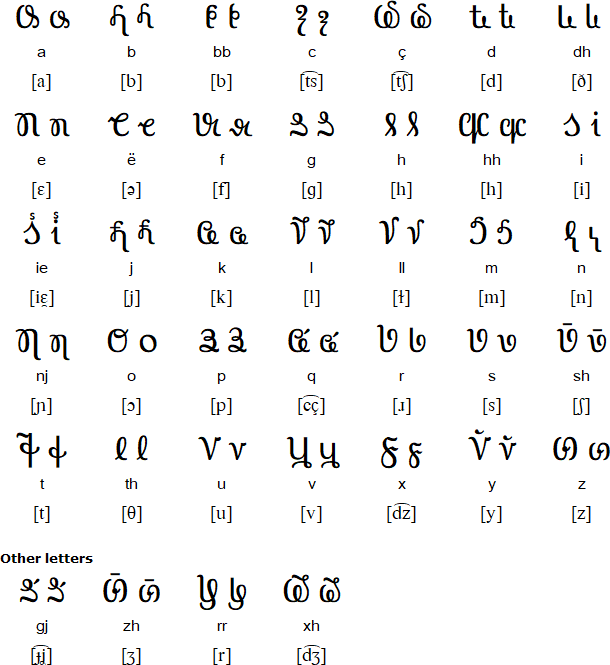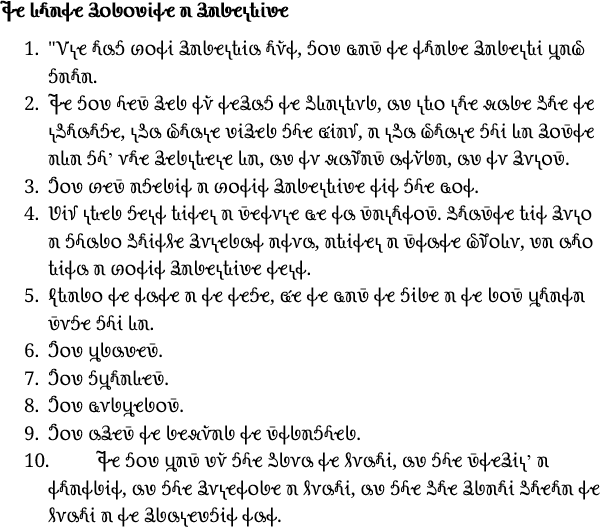The Beitha Kukju alphabet was created between 1825 and 1845 by Naum Veqilharxhi (1797-1854) a lawyer and scholar from Vithkuq, a village in the Korçë region in southern Albania. The name of the alphabet is a corruption of the name Vithkuq. This alphabet was part of Veqilharxhi's promotion of the Albanian National Awakening movement, and he saw it as a way to avoid the religious associations and divisions of the Latin, Greek and Arabic alphabets. Beitha Kukju is also known as Vithkuqi or Büthakukye.
Details of this alphabet first appeared in Evëtori Shqip Fort i Shkurtër (The most Useful and Concise Albanian Alphabet), a primer published by Veqilharxhi in 1844-5. This was distributed in the Korçë region, later in Berat, and proved popular. Veqilharxhi also produced a number of other books in his alphabet, but few survive.

Download an alphabet chart for Beitha Kukju

Source: https://www.unicode.org/L2/L2017/17316-n4854-vithkuqi.pdf
Source: bible.com
Information about Albanian | Phrases (Gheg) | Phrases (Tosk) | Numbers (Gheg) | Numbers (Tosk) | Tongue twisters | Tower of Babel | Beitha Kukju alphabet | Elbasan alphabet | Todhri alphabet
Albanian courses on: Amazon.com and Amazon.co.uk [affilate links]
Information about the Beitha Kukju alphabet
https://en.wikipedia.org/wiki/Vithkuqi_alphabet
https://ru.wikipedia.org/wiki/Виткутьское_письмо
http://www.rbardalzo.narod.ru/4/alb.html
https://eyeondesign.aiga.org/vithkuqi-a-lost-albanian-alphabet-rescued-by-a-design-student/
https://www.unicode.org/L2/L2017/17316-n4854-vithkuqi.pdf
Beith Kukju / Vithkuqi fonts
https://notofonts.github.io/vithkuqi/
Information about Naum Veqilharxhi
http://en.wikipedia.org/wiki/Naum_Veqilharxhi
A-chik Tokbirim, Adinkra, ADLaM, Armenian, Avestan, Avoiuli, Bactrian, Bassa (Vah), Beitha Kukju, Beria (Zaghawa), Borama / Gadabuursi, Carian, Carpathian Basin Rovas, Chinuk pipa, Chisoi, Coorgi-Cox, Coptic, Cyrillic, Dalecarlian runes, Elbasan, Etruscan, Faliscan, Fox, Galik, Georgian (Asomtavruli), Georgian (Nuskhuri), Georgian (Mkhedruli), Glagolitic, Global Alphabet, Gothic, Greek, Hurûf-ı munfasıla, Irish (Uncial), Kaddare, Kayah Li, Khatt-i-Badíʼ, Khazarian Rovas, Koch, Korean, Latin, Lepontic, Luo Lakeside Script, Lycian, Lydian, Manchu, Mandaic, Mandombe, Marsiliana, Medefaidrin, Messapic, Mongolian, Mro, Mundari Bani, Nag Chiki, Naasioi Otomaung, N'Ko, North Picene, Novo Tupi, Nyiakeng Puachue Hmong, Odùduwà, Ogham, Old Church Slavonic, Oirat Clear Script, Ol Chiki (Ol Cemet' / Santali), Old Italic, Old Nubian, Old Permic, Ol Onal, Orkhon, Osage, Oscan, Osmanya (Somali), Pau Cin Hau, Phrygian, Pollard script, Runic, Székely-Hungarian Rovás (Hungarian Runes), South Picene, Sutton SignWriting, Sunuwar, Tai Viet, Tangsa, Todhri, Toto, Umbrian, (Old) Uyghur, Wancho, Yezidi, Zoulai
Page last modified: 01.06.25
[top]
You can support this site by Buying Me A Coffee, and if you like what you see on this page, you can use the buttons below to share it with people you know.

If you like this site and find it useful, you can support it by making a donation via PayPal or Patreon, or by contributing in other ways. Omniglot is how I make my living.
Note: all links on this site to Amazon.com, Amazon.co.uk
and Amazon.fr
are affiliate links. This means I earn a commission if you click on any of them and buy something. So by clicking on these links you can help to support this site.
[top]